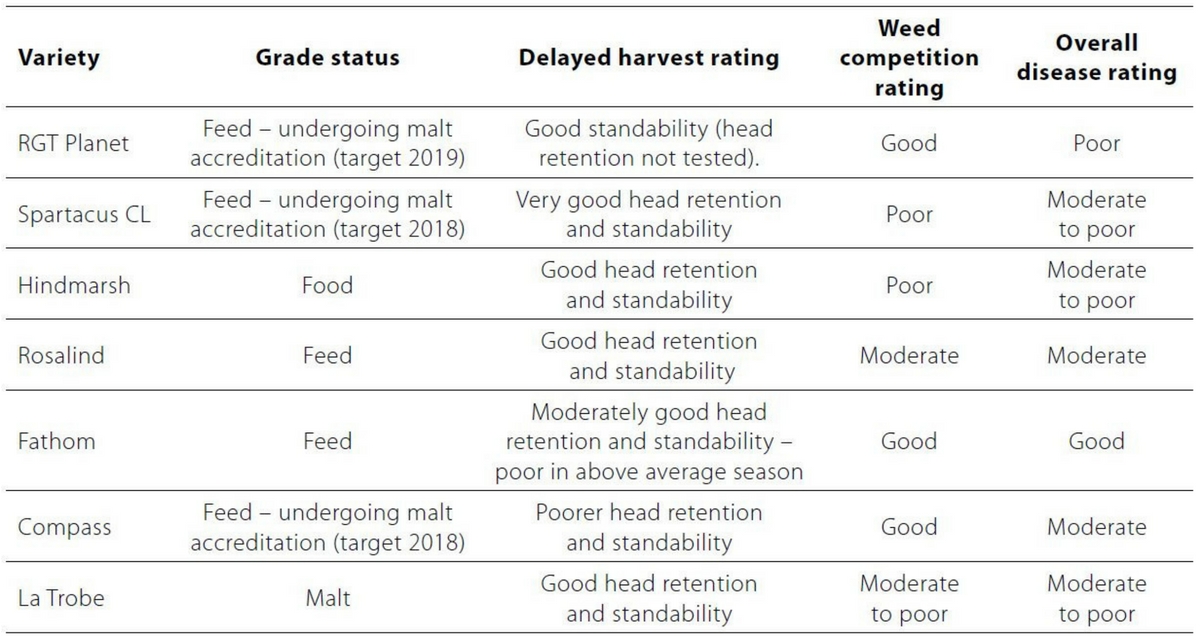Take home messages
- Fathom, La Trobe, Spartacus CL, Rosalind, Hindmarsh and Compass are consistently yielding the highest in the Mallee and Wimmera NVT.
- Compass is very quick to mature and performs better in terms of yield and management at a later sowing time.
- Yields from April and early May sowing flowered too early and were affected by frost events. The June sowing had the highest average yields, but was sown later than ideal for the region.
- Mid to late maturing varieties Urambie and RGT Planet were least affected by frost when sown early May and yielded the highest.
Background
Grain yield is typically defined by an optimal flowering window where there is a compromise between moisture availability, frost and heat risk. New barley varieties differ in phenology, and therefore their suitability to different sowing windows to achieve an optimum flowering time to minimise these risks.
Time of sowing (TOS) is the main management factor that can influence grain number and grain yield. The advantages of sowing early have been evident over the past decade, especially those years with dry finishes. Though early sowing reduces the risk of heat stress during grain filling, it increases the frost risk during flowering. By matching variety to sowing date, seasonal risks can be minimised.
Barley is particularly sensitive to stresses in the period from three to four weeks prior to flowering through to the start of grain fill, as this is when grain number is determined and stem reserves are accumulated. As all paddocks cannot be sown on the optimum date, other paddocks may be compromised. In these circumstances, choosing other varieties better suited to either early sowing or late sowing is advantageous.
Aim
To determine the best sowing window to achieve optimal flowering periods and maximise yield performance in new barley varieties.
Paddock details
| Location: | Corack |
| Crop year rainfall: | 370mm |
| GSR (Apr-Oct): | 249mm |
| Soil type: | Clay |
| Paddock history: | Wheat |
Trial Details
| Crop types: | 12 barley varieties: Biere, Commander, Compass, Fathom, La Trobe, RGT Planet, Rosalind, Spartacus CL, Urambie, Westminster, WI4952 and AGTB0015 |
| Treatments: | Three times of sowing |
| Target plant density: | 140 plants/m² |
| Seeding equipment: | Knife points, press wheels, 30cm row spacing |
| Sowing date: | TOS 1: 19 April 2017, TOS 2: 1 May 2017, TOS 3: 1 June 2017 |
| Replicates: | Four |
| Harvest date: | 30 November 2017 |
| Trial average yield: | TOS 1 – 1.3t/ha TOS 2 – 3.0t/ha TOS 3 – 3.6t/ha |
Trial inputs
| TOS 1 | TOS 2 | TOS 3 | |
| Fertiliser | Granulock Supreme Z + Impact® @ 60kg/ha19 June – Urea @ 100kg/ha at mid tillering stage. |
Granulock Supreme Z + Impact @ 60kg/ha19 June – Urea @ 100kg/ha at early tillering stage. |
Granulock Supreme Z + Impact @ 60kg/ha
24 July – Urea @ 100kg/ha |
| Herbicide | 19 April – Trifluralin @ 1.5L/ha + Avadex® @ 2L/ha + Glyphosate @ 2L/ha
19 June – Velocity® @ |
1 May – Trifluralin @ 1.5L/ha + Avadex @ 2L/ha + Glyphosate @ 2L/ha19 June – Velocity @ 670mL/ha + MCPA LVE @ 400mL/ha + Hasten 1% 24 July – Paradigm® @ 25mL/ha + MCPA LVE @ 500mL/ha + Uptake® 500mL/100L |
1 June 2017 – Trifluralin @ 1.5L/ha + Avadex @ 2L/ha + Glyphosate @ 2L/ha24 July – Paradigm @ 25mL/ha + MCPA LVE @ 500mL/ha + Uptake 500mL/100L |
| Insecticide | 24 July – Lorsban® @ 600mL/ha22 August – Lorsban® @ 600mL/ha |
24 July – Lorsban® @ 600mL/ha
22 August – Lorsban® |
24 July – Lorsban® @ 600mL/ha
22 August – Lorsban® |
| Fungicide | 19 June – Propiconazole @ 300mL/ha24 July – Amistar Xtra® @ 400mL/ha 22 August – Amistar Xtra® @ 400mL/ha |
24 July – Amistar Xtra® @ 400mL/ha22 August – Amistar Xtra® @ 400mL/ha |
24 July – Amistar Xtra® @ 400mL/ha
22 August – Amistar Xtra® |
| Seed treatment | Systiva® @ 150mL/100kg seed, Gaucho® @ 240mL/100kg seed | ||
Method
A split plot design was established at Corack with three sowing times; 19 April (early for the region), 1 May (close to farmer practice) and 1 June (late time of sowing).
Assessments included crop emergence date, GS31 (first node formation) date, GS49 (awn peep) date and GS90 (when all green has been lost from glumes) date for all varieties at each TOS. Grain yield and quality parameters were measured.
Results and interpretation
TOS 1 received adequate rainfall two days after sowing ensuring good germination approximately eight days later. TOS 2 was sown into a moist soil bed, germinating eleven days after sowing (on average). TOS 3 was also sown into relatively moist soil conditions but germinated 19 days after sowing. TOS 3 was affected by mice, so establishment numbers were approximately 30 plants/m2 less than TOS 1 and TOS 2 (approximately 130 plants/m2).
Between August 1 and November 1, the site encountered 29 frost events that fell below zero degrees (Figure 1). During this time, TOS 1 was badly affected through the flowering period, with nearly one hundred percent frost damage in all varieties. Frost scores were completed on each plot to gauge the severity and determine yield penalties within varieties. Severely frosted plots initiated new tillers, however the yield and quality data in TOS 1 was too variable to present. It was interesting to note the compensatory ability of barley after a severe frost event, when adequate rainfall for retillering occurred. Barley yields ranged from 0.8-1.8t/ha, purely from secondary tiller yield.
TOS 2 was also affected by frost, but to a lesser extent (Figure 1). On average, about 10-50 percent of the heads were affected in 50 percent of the plot. Some varieties that were later maturing were less affected (eg. Urambie) and Biere was the most affected (due to its very early maturity, ten days earlier than Hindmarsh). TOS 3 flowered when some frosts were present, but there was only very minor (top few grains on head in later varieties) or no damage seen.
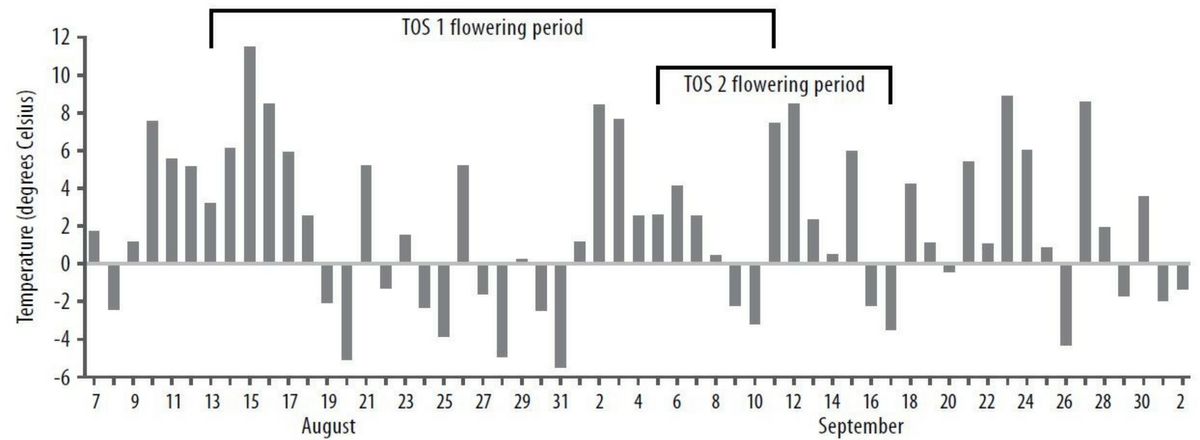
How is flowering date influenced by sowing time and variety?
The time of sowing slightly influenced flowering (GS49) date (Table 1). On average, TOS 2 reached flowering four days after TOS 1, and TOS 3 was quicker, four days earlier than TOS 1. In terms of days to emergence, TOS 3 took a lot longer (19 days after sowing), compared to TOS 1 (8 days), due to cooler soil temperatures when sown later, reducing rate of plant growth.
Table 1. The average days to emergence, plants/m2, days to first node development, awn peep and maturity for the three sowing times.
As sowing time became later, the time it took for varieties to reach GS31 (first node) extended, whereas time to flowering and maturity shortened (Figure 2). Most varieties in all sowing times followed their maturity classification, apart from Compass and Rosalind. Compass (rated as moderately early) is quick to mature, around the same time as Spartacus CL and La Trobe (rated early), despite its slightly later rating.
Rosalind (rated as mid maturing) is quick to progress through early growth stages (GS31 and GS49) when sown earlier (TOS 1 and 2). It was quicker than most early maturing varieties, and was reaching maturity at similar times to Spartacus CL and La Trobe (early maturing).
Biere is a very quick maturing variety (10 days earlier than Hindmarsh) and was noticeably quicker to reach flowering in all sowing times. Urambie and Westminster are very long season varieties, and were 6-12 days later than Compass to flower. Urambie is a true winter variety and requires vernalisation (cold temperature) to flower and can therefore be sown earlier than all other varieties, however is better suited to long season.
The new variety RGT Planet flowered later than Compass and all other quick developing varieties when sown in April and May, however was earlier than Fathom and Commander.
All varieties matured within a few days of each other for each sowing time, this was influenced by the drier finish at the site, as moisture stress became an issue.
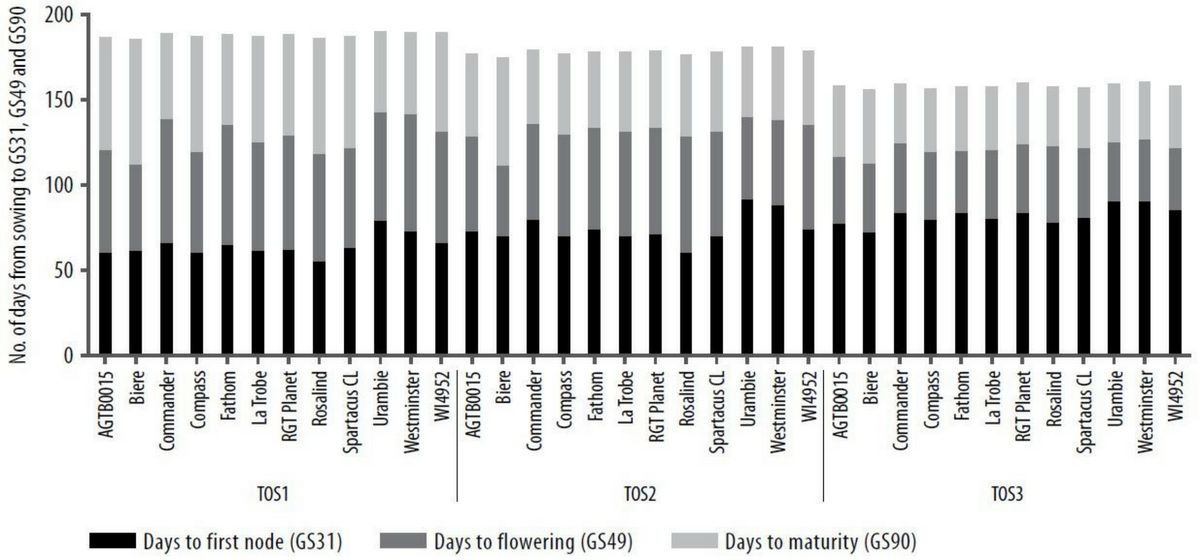
The interaction between flowering date and yield is shown in Figure 3. The earlier the flowering date the greater the yield reduction due to frost damage. Varieties within TOS 2 and 3 that flowered during mid-September, until the end of September produced the greatest yields and weren’t as at risk to frost events.
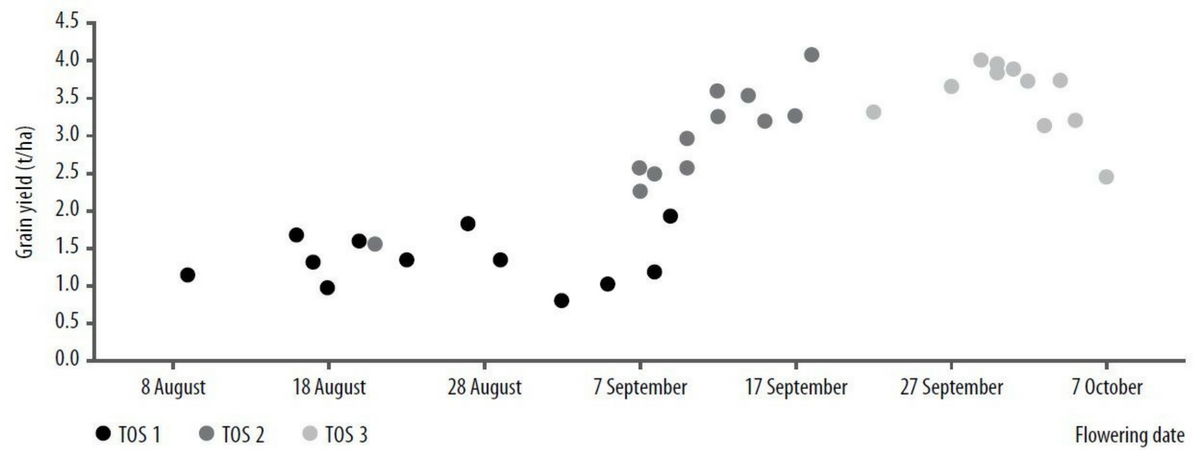
How did TOS influence variety yield performance?
Between TOS 2 and 3 (TOS 1 data excluded due to variability), all earlier to mid maturing varieties performed better in TOS 3 due to no frost damage (Figure 4).
Urambie was the highest yielding, followed by RGT Planet in TOS 2. These varieties are later maturing, so were less affected by frost damage as their flowering window was slightly later than early rated varieties. Very early maturing varieties suffered yield penalties in TOS 2, due to the short season and being affected by frost during flowering.
In TOS 3 Compass, Fathom, Spartacus, La Trobe, RGT Planet, Commander and W14952 similarly yielded the highest. Compass is better sown slightly later due to its quick maturity. This can also help manage the variety in terms of susceptibility to lodging and head loss.
A risk with late sowing is potential heat stress at the end of the season. Late maturing varieties, Urambie and Westminster yielded the lowest in TOS 3 as the season was cut too short for them due to moisture stress. TOS 3 also had mice damage upon emergence, so the barley plants compensated well from a lower plant density.

Grain quality was very poor between the sowing times due to the frost damage and the dry finish at the site, in particular TOS 1 (data not shown). All varieties were graded as Feed 1 or 2 or undeliverable, mainly contributed by the very high protein (between 12.1-14.5%) and low test weights (between 41-63kg/hL) in TOS 2 and the low retention (14-78%), high proteins (12.4-14.2%) and high screenings (4.7-31%) in TOS 3.
How did varieties perform around the region?
Figure 5 compares the 2017 average of all Mallee National Variety Trial (NVT) sites (grain yield as a percentage of the site mean) to the long-term (six year) average of each variety at the Mallee sites. Due to the widespread frost damage in the region, the 2017 Manangatang site data is not included.
RGT Planet again yielded well across all sites, in an average to above average year. Note, this variety has only been trialed for two years, and not in a tough finish like most of the other varieties. Rosalind, (four years data) Compass, Hindmarsh, La Trobe, Fathom and Spartacus CL (four years data) are consistently yielding well across a four to six year average (in a range of seasonal finishes).
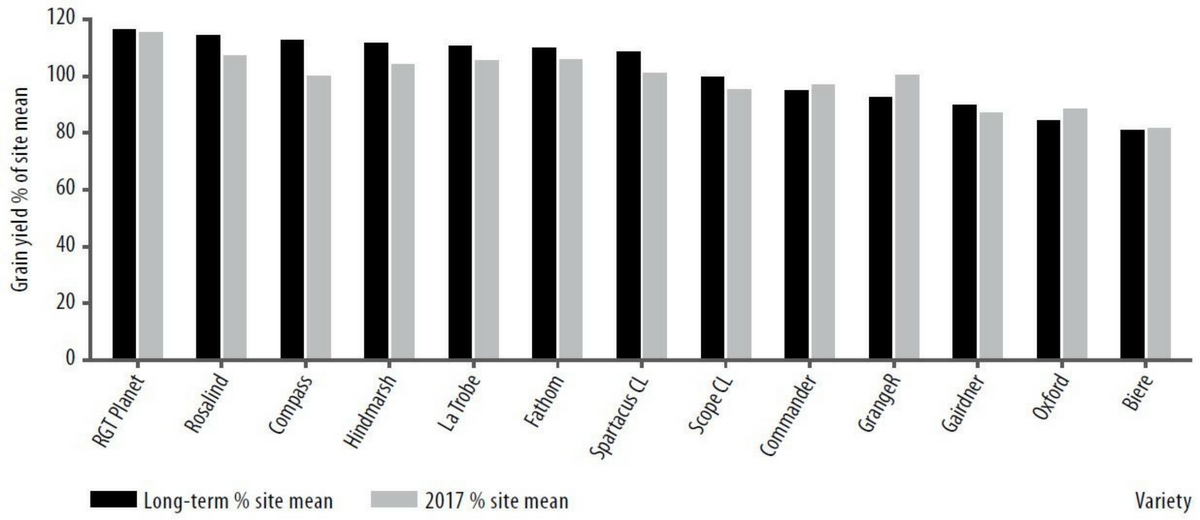
Figure 6 compares the 2017 average of all Wimmera National Variety Trial (NVT) sites (as a percentage of the site mean) to the long-term (six year) average of each variety at the Wimmera sites.
RGT Planet and Rosalind yielded exceptionally well in 2017 in the Wimmera (average of all sites in 2017). Long term averages indicates Rosalind, Compass and Fathom are yielding well across a range of seasonal finishes. Spartacus CL, Hindmarsh and La Trobe, whilst slightly lower (% of site mean), are still yielding well also.
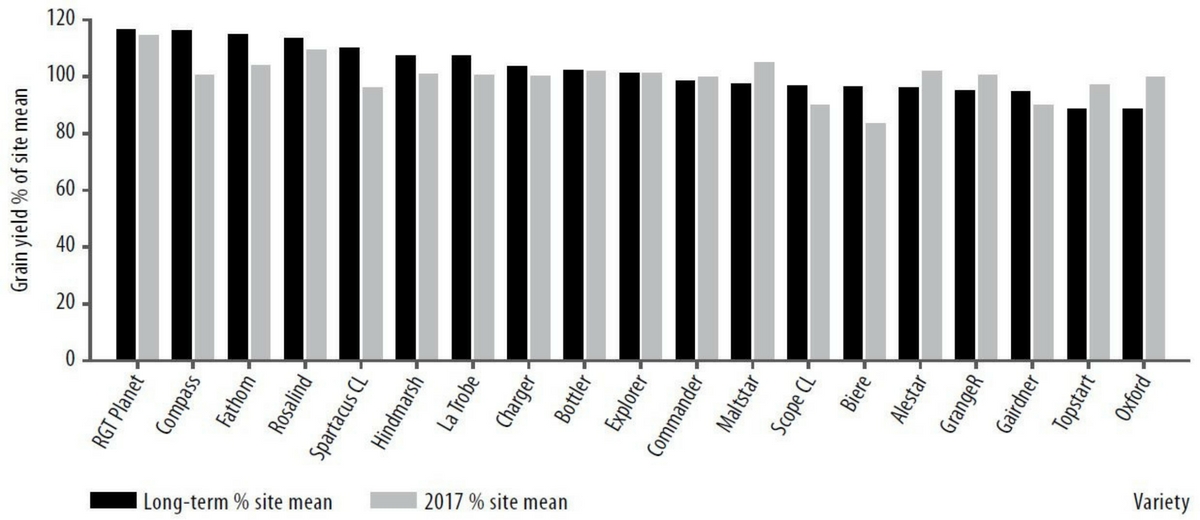
Commercial practice
The 2017 season was met with numerous severe frost events during the growing season, and in particular during critical flowering windows. In this trial, the effects of these frosts made it hard to conclude which varieties are better suited to certain sowing times in 2017, however there are useful examples of varieties that flowered at similar times, yielding differently. This suggests some varieties are better adapted to the region, for example, RGT Planet versus Westminster.
TOS 3 produced the best yields with most varieties yielding similar, highlighting that a range of varieties can fit into a particular farming system and have a good fit from a late time of sowing perspective. It must be noted that the frost events this year where extreme and early May sowing is genuinely favoured, to maximise yield potential. Previous research has shown the benefit of sowing earlier in barley, to gain a yield advantage.
A sound understanding of the phenology of varieties will help to ensure that varieties are sown in the appropriate sowing window to maximise crop potential. Growers should endeavour to learn how to assess their crop growth stage, a practice essential for effective communication between grower and advisor. It provides a common reference for describing the crops development so that agronomic decisions can be implemented, based on a common understanding of which stage the crop has reached.
Looking at variety long term performance provides the best indication for guidance when selecting a variety. RGT Planet offers a unique phenology pattern, being slightly later than current well adapted spring lines La Trobe, Fathom, Compass, Spartacus and Rosalind. Its yield performance has been above average in many environments, particularly in >4 t/ha yield environments. While in lower yielding environments its performance has been more similar to the earlier maturing spring lines. It is a variety to watch over the next few seasons to grasp a true indication of its fit in a range of different seasonal finishes (in low and higher rainfall areas).
Hindmarsh is still performing well, although with La Trobe an accredited Malt variety, offers a good replacement. Fathom, Rosalind, Compass and Spartacus CL are yielding consistently well. Aim for yield by choosing one of these varieties and then look at their individual agronomy packages (eg. disease susceptibility, head loss and lodging risk, competitiveness, grade) to determine the best fit for your farm and when planning rotations (Table 2).
Table 2. An overview of the top yielding varieties and ratings for delayed harvest, weed competition, disease and grade status. More detailed information can be found in NVT BARLEY YIELD RESULTS on pp. 238.
On-farm profitability
Currently La Trobe is the highest yielding Malt accredited variety, giving it an added financial
advantage if Malt grade is achieved. Compass, Spartacus CL and RGT Planet are all undergoing Malt accreditation. On-farm profitability will differ dependant on which variety you choose, but just as importantly, the characteristics it possesses. For example, Compass is high yielding however, with a wet harvest the variety is more prone to head loss and lodging, consequently affecting yield and overall returns. Similarly, a variety that isn’t competitive that is sown into grass weed issues could also suffer penalties. Select a variety that is high yielding and then look at its agronomic characteristics to determine which variety has the best fit for your system and the paddock rotation.
References
Acknowledgements
This research was funded by the GRDC as part of the ‘Barley agronomy for the southern region’ project (DAN00173).

